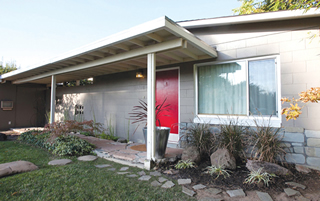Built to Blast - Page 4
Berkeley architect and engineer Walter Steilberg, a close associate of architect Julia Morgan, was another concrete block pioneer from the 1930s on, designing concrete homes and inventing his own construction system, dubbed Fabricrete.
Gus and Steilberg met in the 1930s when Steilberg worked with Basalt Rock Co. on a proposal for workers housing and public housing built of concrete.
During World War II, the Bay Area-based modernist architect Joseph Allen Stein proposed using concrete blocks as the easiest, cheapest way to produce high-quality worker housing. After the war, he designed matching concrete homes for himself and his friend, landscape architect Robert Royston, in Mill Valley.
It was after the war that concrete blocks seemed ready to boom as a housing material. “Build a better concrete block,” Architectural Forum advised in September 1949, “and there will be contractors at your doorstep.”
By the early 1950s, Eichler’s architects, Jones & Emmons, were designing tracts of modern concrete block homes for the Pardee-Phillips company in Southern California and Las Vegas. Other modern designers were using concrete blocks for custom designs.
“Behold the Lowly Concrete Block,” House & Home headlined in March 1956. “It isn’t lowly anymore.”
“It wasn’t so long ago,” the magazine wrote, “that a concrete block would not dare to show its face in polite society.” Soon, “concrete block should become one of the most popular materials in U.S. home building.”
The material appealed to Gus Blomberg, a former real estate man who was working as a sales rep for Cowell Lime and Cement, a major firm with operations throughout the Bay Area. He had no technical education and no college, Ralph says, but was a creative and inquisitive guy—and wondered why concrete blocks had to be so heavy.
“His vision was of lightweight concrete blocks that could be handled by an individual,” Ralph says.
“He did research in the family home, and baked the product in the family stove. It did interrupt a few family meals.”
In 1933, his block attracted the Basalt Rock Co., which agreed to produce it as Basalite. Gus was soon living with his family in a house—of concrete block, of course—on the Basalt Rock property along the Napa River, not far from downtown Napa. He helped the company build several Basalite houses along the nearby Silverado Trail.
After losing most of his sight in an accident, Gus returned to real estate, moving the family to Sacramento in 1939 when a pair of developers thought Basalite homes would attract buyers to their subdivision there, Ralph says. World War II halted the project.
The family spent the war years running a truck farm once operated by Japanese families who had been interned.
After the war, the Blomberg company, later renamed Building Materials, became a family firm, selling Basalite blocks in the Sacramento Valley for the Basalt Rock Co.
The firm, with 15 to 20 employees, was headed by Gus and involved all six of his sons. Gus’s wife, Alice, worked closely with her husband as well. Three sons soon peeled away for other pursuits, leaving Harold, Ralph, and Jerry to work with their father.
Gus, Alice, Ralph, Harold, and Jerry, and their families, all lived within blocks of each other in concrete homes.
If Blomberg homes were born as an outgrowth, almost an afterthought, of the concrete block business, so was their windows and sliding-glass doors enterprise.
Blocks were modular by nature—and standard window sizes did not fit. First they contracted with a firm to construct iron-framed windows to fit, Jerry says. Soon they switched to aluminum along with the rest of the industry. By the late 1960s, they began making their own windows. Their clients included the Streng brothers, who used Blomberg windows and sliders extensively in their Sacramento modern homes.
Basalt Rock Co., meanwhile, was acquired by Dillingham Corp. “They changed their marketing policy and no longer used us as reps,” Ralph says.
 |
|
|
 |
|
|
Blomberg Building Materials, renamed Blomberg Window Systems, remains an active window and doors manufacturer today, still based in Sacramento.




